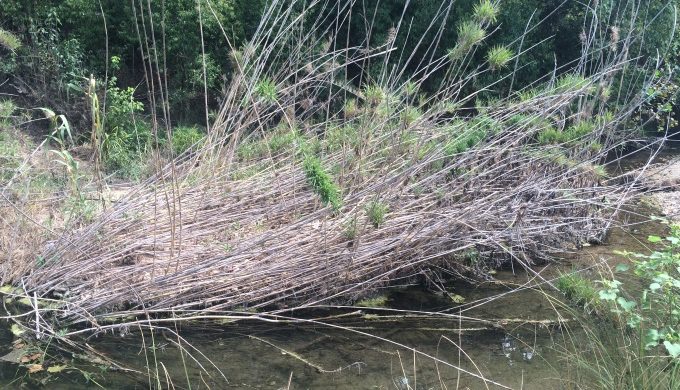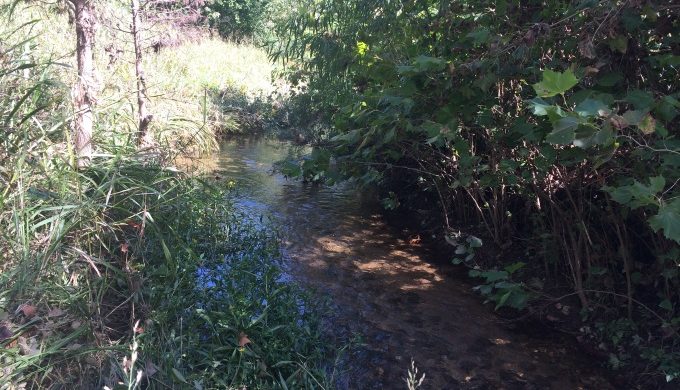The short answer is YES, Texas is being invaded. We in Fredericksburg are on the front lines of a war — on invasive species, being waged by the Texas Parks and Wildlife Department, the City of Fredericksburg, and the Hill Country Alliance. The current target is Arundo donax, aka, giant cane or river cane infesting our creeks and rivers.
 Robert C. Deming
Robert C. Deming
Nature
On the Front Line Against the Invasion of River Cane
This is the battlefield.

Photo: Robert C. Deming
This is a healthy Arundo donax plant in Fredericksburg’s Barons Creek. The plant was brought from Europe, probably Spain, hundreds of years ago. The feathery seed heads are just for show, as this aggressive invader has evolved to reproduce from pieces which are cut off and lodge elsewhere in the creek. This plant grows up to two inches per day, reaching about 30 feet tall, and if unchecked, will fill up the entire river channel and infest the downstream areas with more. Burning the cane doesn’t work — the plant contains so much wax that the fire easily gets out of control, and the plant grows back from the roots. Cutting or digging the cane up doesn’t work, either, and spreads pieces into the creek which may start a new infestation downstream.
These field biologists from Texas Parks and Wildlife are mapping plants to be sprayed.

Photo: Chelsea Pavliska
These TPWD biologists spent much of the past summer in the creeks in Fredericksburg collecting landowner participations, mapping locations of Arundo colonies, and supervising spraying by a contractor. They are passionate about their job of reducing the impact of invasive species on special places in Texas like the Hill Country, and would rather be in the creek than just about anywhere else.
Is the herbicide used dangerous?

Photo: Robert C. Deming
This plant was sprayed a year earlier; notice that there are some segments coming back, and it had to be treated again. Some people ask, “Is this chemical treatment dangerous?” The herbicides used are very specific to plants and approved by the U.S. Environmental Protection Agency and TDA for use over water, and there is great care taken to minimize overspray onto nearby plants or into the creek. The quality of the creek and its plant and animal life is being monitored both above and below the treated areas; so far no problems have been identified. The herbicide is not dangerous to humans if used properly.
This is what a healthy creek looks like.

Photo: Robert C. Deming
This is what a healthy creek looks like: water runs clear, tall native grasses and flowers grow unmowed on the banks, lined by native trees. Infestations of Arundo block the water flow, trap sediment, and debris, make erosion worse, deepen the creek bed, and destroy habitat for important species like the Texas State Fish — the Guadalupe Bass. Native plants hold the soil, preventing erosion in times of high flow and flood. As they say about stream beds: “Wood is Good!” This is Barons Creek in Fredericksburg; a study of Arundo infestations in the Pedernales River showed that the invasive plant starts right here, so control efforts start here and move downriver. Because it spreads so quickly, the goal is 100% landowner participation to help prevent reinfestation. A similar campaign in the Nueces River in the western part of the Hill Country has been long but successful, and recent efforts in the Blanco River seek to keep Arundo from gaining a foothold after the damage done by record flooding. The Nueces River Authority has also created an owners manual for creeks and rivers.
This is a favorite hangout for the biologists at the end of a long day in the creek.

Photo: Robert C. Deming
At the end of the day, you may find these young biologists hanging out at this place, winding up paperwork and talking about the day. Interviewed for the article: Monica McGarrity, BS Biology Old Dominion University, MS Biology-Florida Atlantic University- Aquatic Invasive Species Team Leader, Texas Parks and Wildlife; Chelsea Pavliska, BS Aquatic Biology – Texas State University (Dec 2016)- Aquatic Invasive Species Technician, Texas Parks and Wildlife; Zach Horstman, Univ of Nebraska- BS Fisheries and Wildlife, Lochow Ranch Pond and Lake Management; Lee Schoech, BS Biology/MS Marine Biology – Texas A&M Corpus Christi – Lochow Ranch Pond and Lake Management. For more information on this, check the TPWD website on the program or email [email protected]. More information is also available on the Hill Country Alliance website.

